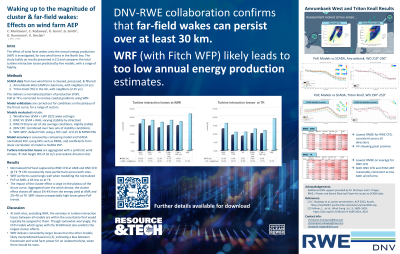Back

Waking up to the magnitude of cluster & far-field wakes: Effects on wind farm AEP
Tuesday, October 1, 2024
5:00 PM – 6:00 PM MST
Location: Regency D


Elizabeth A. Traiger, Ph.D
Senior Consultant
DNV, Colorado
Poster Presenter(s)
Presentation Description: Wind farm wakes propagate & persist offshore over distances of tens of kilometres in stable atmospheric conditions. As wind farms are built in the US Eastern Seaboard, the impact of cluster wakes on wind farm annual energy production (AEP) increases over time & are an emergent risk to LCOE.
To understand the potential biases & uncertainties when modelling cluster wakes, DNV & RWE embarked on a validation exercise, for the operational wind farms of Amrumbank & Triton Knoll, with a focus on wind directions where the object wind farm is in the partial wake of neighbouring clusters. In the validation, pattern of production (PoP) from two CFD models and two engineering models are compared with operational data.
We delve into details regarding the various models’ performance and respective ability to capture effects that are a manifestation of blockage, internal or external wakes. We review the sensitivity of the model results to the characteristics of the modelled atmospheric conditions (stability, boundary layer height). The impact of non-homogeneity in the background flow, due to coastal transition, and its potentially confounding effect when interpreting observed PoP is discussed.
Evidence mounts that atmospheric stability plays an important role at larger scales with respect to static and dynamic effects. Discussed is the potential impact of this & the risk associated with the lack of understanding and measurements of the marine boundary layer for the purposes of parameterising turbine interaction models.
Predicted turbine interaction losses (aggregated wakes & blockage) from all models is compared. We draw conclusions on the effect that the choice of model, setup & site-specific stability distribution input can have on the predicted AEP.
To understand the potential biases & uncertainties when modelling cluster wakes, DNV & RWE embarked on a validation exercise, for the operational wind farms of Amrumbank & Triton Knoll, with a focus on wind directions where the object wind farm is in the partial wake of neighbouring clusters. In the validation, pattern of production (PoP) from two CFD models and two engineering models are compared with operational data.
We delve into details regarding the various models’ performance and respective ability to capture effects that are a manifestation of blockage, internal or external wakes. We review the sensitivity of the model results to the characteristics of the modelled atmospheric conditions (stability, boundary layer height). The impact of non-homogeneity in the background flow, due to coastal transition, and its potentially confounding effect when interpreting observed PoP is discussed.
Evidence mounts that atmospheric stability plays an important role at larger scales with respect to static and dynamic effects. Discussed is the potential impact of this & the risk associated with the lack of understanding and measurements of the marine boundary layer for the purposes of parameterising turbine interaction models.
Predicted turbine interaction losses (aggregated wakes & blockage) from all models is compared. We draw conclusions on the effect that the choice of model, setup & site-specific stability distribution input can have on the predicted AEP.
